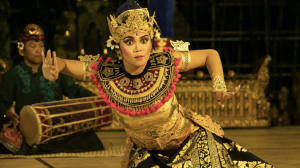The Gamelan Çudamani dance performance was something that I have truly never experienced before. This performance gave me an idea of the values, traditions, and beliefs in Balinese culture. The show was introduced by a male only instrumental scene. Then, male and female performers dressed head to toe in colorful traditional Balinese outfits. Women danced around the stage while the men played loud instruments. The music and dancing were in sync, so that every beat played was a shift in the dancer’s position. Their facial expressions were powerful and exaggerated and their eyes would open so wide that it looked as if they were being possessed by the music. Each song the musicians played held a different emotion, allowing the dancers to imitate that emotion through their facial expressions. The dance moves were unlike any American or European dancing I have seen because their bodies had the ability to bend a very specific way. The dancers’ feet curved dramatically and two of their fingers would pulse as if there was wind blowing through their bodies. Their fingering and body movements were stylized. It was clear that any ordinary person would not have been able to attempt their form of dancing without failing miserably. Due to the music, dancing, and look, it is clear that this performance illustrated identity and gender.
When we were first assigned to attend a theatre performance I was very confused. This class is based on media representations, and a performance is not necessarily media. However, after watching the Gamelan Çudamani dance performance I was able to understand that although this does not fit into the elementary definition of “media”, the performers were able to communicate their identity and culture with the audience, allowing this performance to be considered a form of media. By wearing vibrant outfits that covered almost every inch of their body showed their culture through self presentation. Myria Georgiou points out, in her piece “Identity”, that one of the ways people can show their identity is through how they present themselves. She explains how it is important to perform identity and find ways to locate self in the world. The performers all danced alike, moving their bodies in a very specific way. Each song and dance scene represented a different Balinese cultural belief. For instance, the bridge performance was connected to the ocean. In another performance the dancers wore traditional Balinese masks. Gender norms were also displayed throughout the performance. Most of the men would play instruments while the women danced. It was not until later in the performance that the men started to dance and the women started to play. Their outfits were also somewhat different. Since the women wore more striking and colorful outfits, one could presume that females must appear a certain way in Balinese culture. The main connection between the two genders portrayed in this performance was the music. Although their physical appearances were different, the music formed a bond between the males and females. Since the music and dancing were connected it allowed the performers to be connected through movements and sounds.
This performance shared a lot about Balinese culture norms, values, and traditions. Overall, I can conclude that I was able to view the power behind this performance due to my knowledge of the keywords identity and gender.

